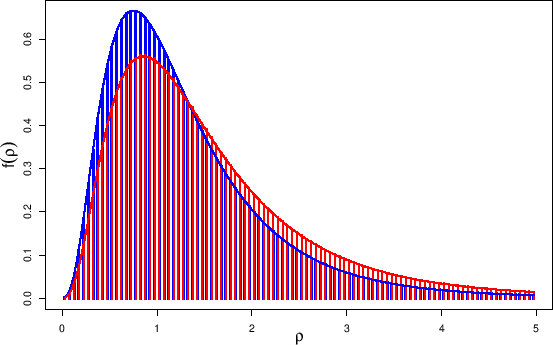An overall comparison of the two models,
again based on the observations
of 3 counts in 3 s from process 1 and
6 counts in 6 s from process 2, is shown in
Fig. ![[*]](crossref.png) ,
,
Figure:
Comparison of the distribution of
 obtained
by the models of Fig.
obtained
by the models of Fig. ![[*]](crossref.png) (blue, slightly
narrower)
and Fig.
(blue, slightly
narrower)
and Fig. ![[*]](crossref.png) (red, slightly wider) in the case of
(
(red, slightly wider) in the case of
(
 s) and (
s) and (
 s) using
flat priors for the top nodes. The histograms are the JAGS
results and the lines come from the pdf's in closed form (see text).
s) using
flat priors for the top nodes. The histograms are the JAGS
results and the lines come from the pdf's in closed form (see text).
 |
while expected values
and standard deviations (separated by ` ') calculated
from the closed formulae
are summarized in the following table.
') calculated
from the closed formulae
are summarized in the following table.
| |
Model A (Fig. ![[*]](crossref.png) ) ) |
Model B (Fig. ![[*]](crossref.png) ) ) |
| |
![$[\,f_0(r_1)\!=\!k\ \& \ f_0(r_2)\!=\!k\,] $](img525.png) |
![$[\,f_0(\rho)\!=\!k\ \&\ f_0(r_2)\!=\!k\,] $](img526.png) |
 s s |
 |
 |
 s s |
 |
 |
 |
 |
 |
As we have seen in Fig. ![[*]](crossref.png) ,
the second model produces a distribution of
,
the second model produces a distribution of  with
higher expected value and higher standard deviation.
with
higher expected value and higher standard deviation.
![[*]](crossref.png) ,
,
![[*]](crossref.png) ,
the second model produces a distribution of
,
the second model produces a distribution of